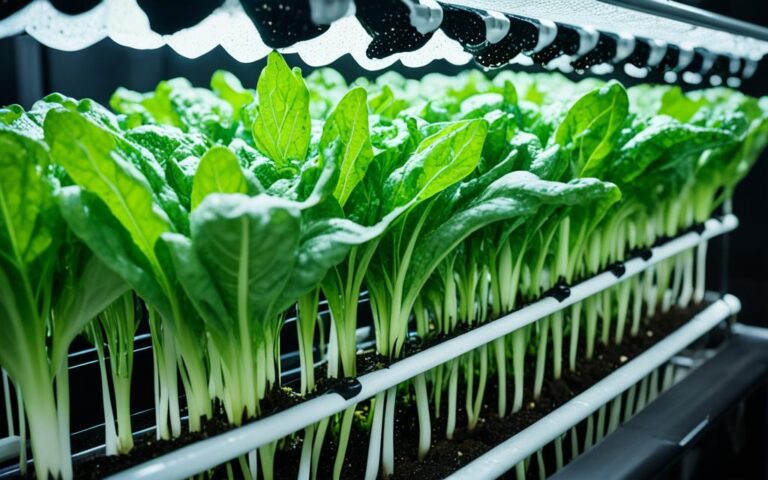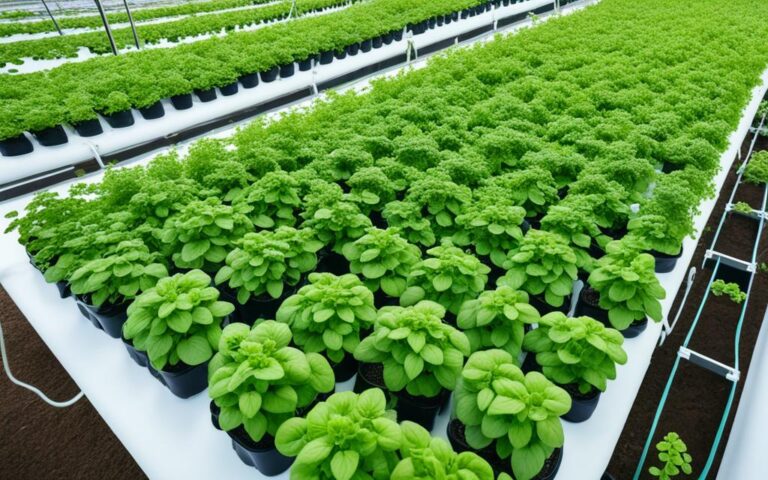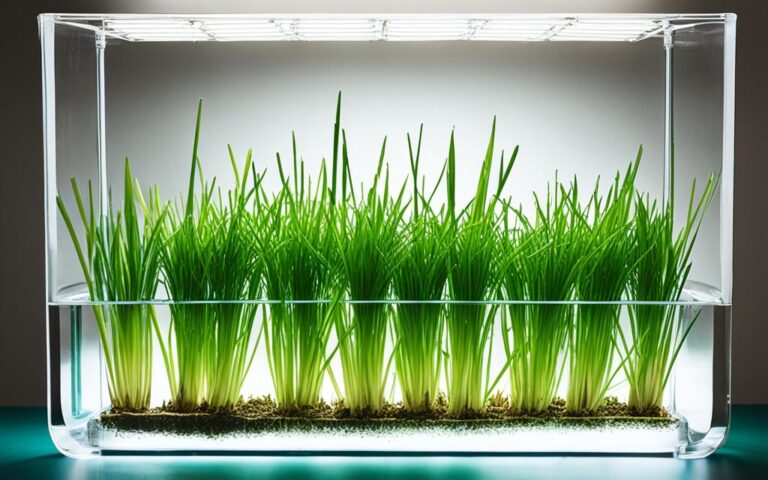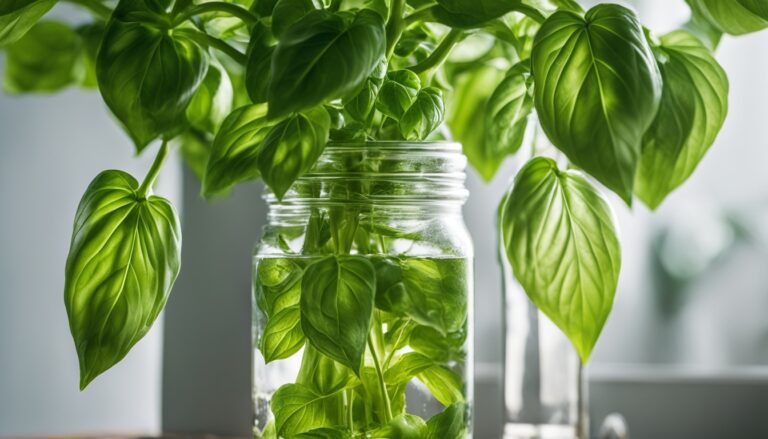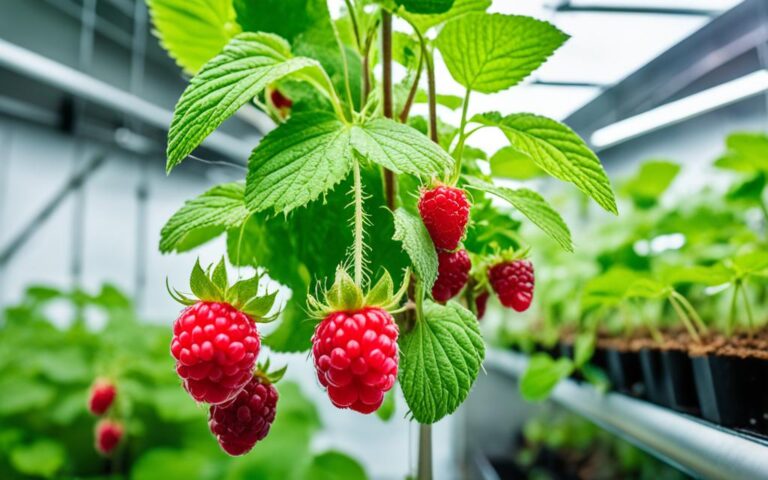Growing Hydroponic Carrots: Tips for Success
Learn how to grow hydroponic carrots, a nutrient-rich and vitamin A-packed root vegetable. This guide is for both experienced indoor farmers and passionate home gardeners. We’ll cover everything you need to know to grow hydroponic carrots successfully.
From picking the best carrot varieties to setting up your hydroponic system, we’ve got you covered. Follow our steps to create a thriving hydroponic carrot garden.
Key Takeaways
- Hydroponic carrot cultivation offers faster growth, improved yields, and greater water and nutrient efficiency compared to traditional soil-based methods.
- Selecting the right carrot varieties, such as Nantes, Danvers, and Chantenay, is crucial for optimal performance in hydroponic systems.
- Properly setting up the hydroponic system, choosing the right growing medium, and providing the necessary nutrients and lighting are essential for healthy carrot development.
- Monitoring and adjusting the nutrient solution, pH levels, and environmental conditions are critical for ensuring the optimal growth and quality of hydroponic carrots.
- Hydroponic carrots can be a challenging crop for newcomers, but with the right techniques and attention to detail, you can achieve a bountiful harvest of these versatile root vegetables.
Table of Contents
Understanding Hydroponics: A Soilless Cultivation Method
Hydroponics is a new way to grow plants without soil. It uses a nutrient-rich water solution instead. This method is popular for growing vegetables and crops like hydroponic carrots.
Hydroponics lets growers control what nutrients plants get. This means plants grow better and stronger. It’s great for growing many types of vegetables and organic produce indoors.
“Hydroponics accelerates plant growth by providing the exact nutrients and conditions needed, leading to yields up to 30% faster than traditional soil-based methods.”
Hydroponics is also good for saving water and space. It uses up to 90% less water than traditional farming. This makes it a green choice for growing food indoors or in cities.
There are many types of hydroponic systems for different growers. Whether you’re growing carrots or exploring indoor farming, hydroponics opens new doors for your garden or farm.
Selecting the Right Carrot Varieties for Hydroponic Growing
Choosing the right carrot variety is key to a successful hydroponic harvest. Not all carrots grow well without soil. It’s important to pick the best hydroponic carrot varieties for this special growing method.
Best Carrot Varieties for Hydroponics
Top carrot varieties for hydroponics include:
- Nantes carrots: These have a sweet, tender taste and a cylindrical shape that is well-suited for hydroponic cultivation. They also have a relatively short maturity time.
- Danvers carrots: Known for their tapered, conical shape, Danvers carrots thrive in hydroponic setups and are a popular choice among growers.
- Chantenay carrots: These shorter, thicker carrots with a distinct cone shape are ideal for growing in limited spaces, making them a great option for hydroponic systems.
Characteristics to Look for in Hydroponic Carrot Varieties
When picking the best carrots for your hydroponic garden, look for these traits:
- Tolerance to Wet Conditions: Carrots in hydroponics need to handle moist roots all the time. They’re always in the nutrient solution.
- Root Formation and Shape: Carrots with well-shaped roots do better in hydroponics. Irregular shapes can be harder to grow.
- Nutrient Requirements: Knowing what nutrients each carrot variety needs helps you pick the best ones for your hydroponic setup.
Choosing the right hydroponic carrot varieties and their traits will help you get the best quality and yield from your hydroponic carrots.
Setting Up Your Hydroponic System for Carrots
Growing carrots hydroponically means you need a well-designed system for the best results. You’ll need a growing tray, a nutrient reservoir, a water pump, and a grow light system.
Essential Components of a Hydroponic System
To start your hydroponic system for carrots, gather these key parts:
- Growing Tray: This tray is where you plant the carrot seeds or seedlings. Make sure it’s deep enough for the carrot’s roots, about 8-12 inches deep.
- Nutrient Reservoir: This container holds the nutrient-rich water. Keep an eye on the nutrient levels to help your carrots grow well.
- Water Pump: The pump moves the nutrient solution from the reservoir to the growing tray. This keeps the roots getting nutrients and oxygen.
- Grow Lights: Carrots need 10-12 hours of light every day to grow well. Good grow lights give the right intensity and spectrum for indoor growing.
Choosing the Right Growing Medium
The growing medium you pick is very important. A mix of coco coir and perlite, or Rockwool cubes, works great for hydroponic carrots. These materials help the carrot roots grow and get nutrients and water well.
| Hydroponic System | Suitable Carrot Varieties | Key Considerations |
|---|---|---|
| Deep Water Culture (DWC) | Thumbelina, Short ‘n Sweet | Make sure the taproots aren’t submerged |
| Ebb and Flow | Nantes, Purple Dragon | This method helps with root vegetables by flooding and draining |
| Nutrient Film Technique (NFT) | Danvers, Imperator | Helps root development with the right channel structure |
| Media-based Systems | Yaya Hybrid, Chantenay | Supports heavy carrots with a mix of hydroponic and soil-like stability |
Choosing the right hydroponic system and growing medium makes your hydroponic carrot garden perfect for growing.
Preparing the Growing Medium and Planting hydroponic Carrots
Before you start growing hydroponic carrots, you need to prepare the growing medium well. This step is key for a successful carrot harvest. Let’s look at the details:
- Soak the coco coir and perlite mixture or Rockwool cubes in water for 24 hours. This makes sure the growing medium is fully saturated and ready for planting.
- The growing medium should be at least 30cm (12 inches) deep when planting hydroponic carrots.
- Carrot seeds should be planted 1cm (1/2 inch) deep in the growing medium.
Once the growing medium is ready, it’s time to plant the carrot seeds. Make sure to space them about 1cm (1/2 inch) apart in the growing trays or containers. This allows the carrots to grow well and reach their full size.
| Material | Cost |
|---|---|
| Carrot Seeds | $2.48 |
| Organic Seed Starting Jiffy-Mix (2 Liters) | $2.49 |
Don’t forget to make several small holes in the container’s bottom for drainage. The soil should be about an inch from the top. The holes for the seeds should be 1/8 inch deep, spaced 2 inches apart.

Carrots need 6 hours of sunlight a day and a temperature between 7°C to 30°C (45°F-86°F). As the seedlings grow, you’ll need to water them with nutrient solution 2 to 3 times a day.
By preparing the growing medium and planting the seeds correctly, you’re setting up for a great hydroponic carrot harvest. This will happen in the weeks and months ahead.
Caring for Your Hydroponic Carrot Garden
Keeping a hydroponic carrot garden healthy means watching over it closely and making sure it gets what it needs. This includes checking the nutrient solution often and making sure it has the right amount of light and temperature. Taking care of your hydroponic carrot garden needs a lot of effort.
Monitoring and Adjusting Nutrient Solution
It’s important to check the pH and EC levels of the nutrient solution for your hydroponic carrots often. The ideal pH is between 6.0 and 6.5, and the EC should be moderate for healthy growth. Adjusting the solution as needed helps your carrots grow well and produce lots of food.
Providing Optimal Light and Temperature
Hydroponic carrots need a steady supply of good quality light to grow. Use full-spectrum lights like high-pressure sodium or metal halide lamps for the best results. These lights should be on for 16 to 18 hours a day. Also, keep the temperature between 65 and 75 degrees Fahrenheit for healthy growth.
By keeping an eye on the nutrient solution, providing enough light, and keeping the temperature right, your hydroponic carrot garden will do great. These steps are key to growing tasty, healthy carrots without soil.
“Hydroponic carrot cultivation allows for precise control over the growing environment, leading to improved flavor, texture, and nutritional value compared to conventionally grown carrots.”
hydroponic Carrots: Nutrient Requirements and Fertilizers
Growing hydroponic carrots means knowing what they need to grow well. Carrots need a lot of nutrients to develop strong roots and grow big. They take in important macro and micronutrients for their growth.
Essential Nutrients for Carrot Growth
Carrots need these main nutrients:
- Nitrogen (N) – Helps with leaves and plant health.
- Phosphorus (P) – Good for root growth and getting established.
- Potassium (K) – Keeps plants healthy, helps with drought, and improves roots.
They also need smaller nutrients like calcium, magnesium, boron, and more for the best growth.
Choosing the Right Hydroponic Fertilizer
For carrots, pick a fertilizer with a balanced mix of nutrients. Aim for a formula with an N-P-K ratio of 5-15-15. This mix helps with strong roots and sweet carrots. It’s important to keep the nutrient solution’s EC level right, between 1.2 to 2.0 mS/cm, for healthy carrots.
| Nutrient | Ideal Range for Hydroponic Carrots |
|---|---|
| Nitrogen (N) | 80-130 kg/ha |
| Phosphorus (P) | Moderate to high |
| Potassium (K) | High |
| Calcium (Ca) | Moderate |
| Magnesium (Mg) | Moderate |
| Boron (B) | Moderate |
| pH | 6.0 – 6.5 |
| EC | 1.2 – 2.0 mS/cm |

Knowing what nutrients carrots need and choosing the right fertilizer helps growers. This way, carrot plants get what they need to grow well and produce tasty roots.
Watering and Irrigation for Hydroponic Carrots
Watering and irrigation are key for growing hydroponic carrots well. A drip system works great because it keeps the right moisture level. You should water hydroponic carrots 2-3 times a day. The goal is to keep the soil damp but not too wet.
Maintaining the Ideal Moisture Level
Carrots need specific conditions to grow well. They like a slightly acidic soil with a pH of 6.0–6.8. The soil should be damp but not too wet.
Here are tips for the right moisture level:
- Check the soil moisture often and adjust how often you water.
- Keep the soil consistently damp all day, without big changes.
- Change how often you water based on the temperature, humidity, and growth stage.
- Use tools like a moisture meter to check the soil moisture accurately.
- Don’t over-water, as it can cause root rot and disease.
Keeping the right moisture helps your hydroponic carrots grow well. This means a bigger harvest.
| Hydroponic Carrot Watering Recommendations | Seedling Stage (Days 1-7) | Vegetative Stage | Flowering/Fruiting Stage |
|---|---|---|---|
| Watering Frequency | Every 2-3 hours for 15 minutes | Every 4-6 hours for 10-15 minutes | Every 3-4 hours for 15-20 minutes |
| Moisture Level | Consistently damp | Consistently damp | Consistently damp |
| Monitoring | Check regularly and adjust as needed | Check regularly and adjust as needed | Check regularly and adjust as needed |
Proper watering and irrigation are vital for growing hydroponic carrots. Keeping the right moisture level helps your carrots grow healthy and big.
Monitoring pH and EC Levels for Optimal Growth
Keeping the right pH and electrical conductivity (EC) levels in your hydroponic carrot solution is key. The ideal pH for carrots is between 6.0 and 6.5. This ensures they get the nutrients they need. The EC, which measures nutrient concentration, should be between 1.2 and 2.0 mS/cm. Testing and adjusting these levels regularly will help your carrots grow well.
Electrical Conductivity (EC) shows how dense the nutrients are in the water. It’s measured in milliSiemens per centimeter (mS/cm) or microsiemens per centimeter (μS/cm). A higher EC means more dissolved salts, while a lower one means less. By keeping an eye on EC and adjusting the nutrient solution, growers can avoid nutrient problems and help plants grow better.
| Plant Type | Optimal pH | Optimal EC (mS/cm) |
|---|---|---|
| Hydroponic Carrots | 6.0 – 6.5 | 1.2 – 2.0 |
| Lettuce | 5.5 – 6.5 | 1.5 – 2.5 |
| Tomatoes | 5.5 – 6.5 | 2.0 – 3.5 |
| Strawberries | 5.5 – 6.5 | 1.0 – 1.5 |
Checking EC levels is important, but so is keeping the pH right for hydroponic carrots. The right pH range, 6.0 to 6.5, makes nutrients available to the plants. By testing and adjusting the pH with pH solutions, you can make sure your carrots get what they need to grow well.
By watching both pH and EC levels, you can make the perfect environment for your hydroponic carrots. This leads to a big and quality harvest.

Lighting Strategies for Growing Hydroponic Carrots
To grow healthy hydroponic carrots, you need a good lighting plan. Carrots need a lot of light, about 14-16 hours a day, to grow well. It’s important to know how much light carrots need for a good hydroponic setup.
Understanding Carrot Light Requirements
Carrots do best in cooler temperatures, between 60-75°F (16-24°C). They need at least 14 hours of light each day to grow well. The light they use for photosynthesis is in the 400 to 700 nanometer range.
Best Lighting Options for Hydroponic Carrots
LED grow lights are great for hydroponic carrot gardens. They give the right kind of light and don’t get too hot. This is good for hydroponic systems where keeping the temperature right is important.
Make sure your hydroponic carrots get enough light. For the growing stage, aim for a light intensity of at least 200 μmol/m²/s. For the flowering and fruiting stages, you might need 600 μmol/m²/s or more. Adjusting the light helps your carrots grow well.
| Lighting Parameter | Recommended Range |
|---|---|
| Photoperiod (daily light exposure) | 14-16 hours |
| Photosynthetically Active Radiation (PAR) | 400-700 nanometers |
| Photosynthetic Photon Flux Density (PPFD) |
|
| Daily Light Integral (DLI) | At least 12 mol/m²/day |
Using these lighting tips and keeping an eye on the light levels will help your hydroponic carrots grow well. They’ll get the light they need for strong growth and lots of carrots.
Common Challenges and Solutions in Hydroponic Carrot Cultivation
Growing carrots in hydroponics has its own set of challenges. But, with the right knowledge and steps, growers can beat them. Two big issues are nutrient problems and pests and diseases.
Nutrient Deficiencies and Imbalances
Nutrient issues can cause carrots to grow poorly. They might have discolored leaves or stunted growth. To fix this, it’s key to test and adjust the nutrient solution often. Keeping an eye on the solution’s pH and EC levels is also vital for healthy carrots.
Pests and Disease Management
Hydroponic carrots can face pests and diseases too. Problems like root rot and aphids are common. To fight these, keep the growing area clean and watch for early signs of trouble. Using organic controls can also help. Addressing issues quickly is crucial to protect your crop.
| Common Challenges | Potential Solutions |
|---|---|
| Nutrient Deficiencies and Imbalances |
|
| Pests and Diseases |
|
By tackling these common challenges, hydroponic carrot growers can boost their garden’s success. With the right techniques and strategies, they can beat these hurdles and enjoy a great harvest.
“Proactive pest and disease management is crucial for maintaining a thriving hydroponic carrot crop. Early detection and swift action can make all the difference in preventing significant losses.”
Harvesting Your Hydroponic Carrots
Knowing when and how to harvest your hydroponic carrots is key for a great crop. Look for signs like the carrot tops showing and the leaves turning deep green. Hydroponic carrots usually take 60-90 days to mature after planting, depending on the type.
Signs of Maturity and Ideal Harvesting Time
When your hydroponic carrots are ready, the tops will be more visible, and the leaves will turn deep green. You might also see the carrots’ shoulders sticking out. Harvest them between 60-90 days after planting, based on the variety.
Proper Harvesting and Storage Techniques
Harvest your hydroponic carrots gently to avoid damage. You can pull them up by the greens or use a small fork to loosen the soil. Handle them with care since they’re delicate.
After harvesting, cut off the greens, leaving an inch of stem. This keeps the carrots fresh in storage.
Store your hydroponic carrots in a bag or container with holes in the fridge. This keeps them crisp and tasty. Stored right, they can last up to two weeks in the fridge.
| Harvesting Technique | Ideal Harvesting Time | Storage Duration |
|---|---|---|
| Gently pull or use a hand fork to lift carrots | 60-90 days after planting | Up to 2 weeks in the refrigerator |
“Proper harvesting and storage techniques are essential for ensuring the quality and longevity of your hydroponic carrot crop.”
Maximizing Yields and Continuous Production
To get the most from your hydroponic carrots, try crop rotation and succession planting. These methods help keep pests and diseases away and ensure a steady supply of fresh carrots. By rotating crops and planting new seeds often, you can have carrots ready to eat all season long.
Crop Rotation for Hydroponic Carrots
Crop rotation is key for healthy soil and pest control in your hydroponic garden. Switching where you grow carrots with other veggies like beets or radishes breaks the life cycle of pests. This keeps your carrots safe and your hydroponic setup working well for a long time.
Succession Planting for Continuous Carrot Production
Succession planting is great for getting more carrots and keeping them coming. Plant new seeds every 2-4 weeks to have carrots ready when you need them. This way, you won’t get a huge harvest all at once, which can be a problem.
Using crop rotation and succession planting together can really boost your hydroponic carrot production. You’ll have a steady supply of fresh carrots and a healthy, productive system.
| Strategy | Benefits |
|---|---|
| Crop Rotation |
|
| Succession Planting |
|
With these strategies, hydroponic carrot growers can maximize their yields and enjoy continuous production. This means a steady supply of high-quality carrots all year.
Benefits of Growing Hydroponic Carrots
Growing carrots hydroponically has many benefits for gardeners and farmers. These carrots taste better and are more nutritious than those grown in soil. They don’t have to fight pests and diseases, so they can focus on being tasty and full of nutrients.
Improved Flavor and Nutrition
Research shows hydroponic carrots are better in taste and nutrition than soil-grown ones. The University of Agricultural Sciences found they grow faster and are more nutritious, needing fewer chemicals. A study in the Journal of Hydroponic Agriculture also showed hydroponic beetroots have more antioxidants than soil-grown ones.
Water and Space Efficiency
Hydroponics uses less water and takes up less space than traditional gardens. This makes it perfect for city and indoor growers. It’s also better for areas with little water or space.
Hydroponic systems have many benefits over soil gardening. They offer better control over growing conditions, faster growth, and more carrots per area. This means growers can get high-quality, tasty carrots all year, even in tough places or cities.
“Hydroponic carrots often exhibit enhanced flavor and higher nutrient content compared to their soil-grown counterparts, as the plants can focus their energy on producing flavorful, nutrient-dense roots without the constraints of soil-borne pests and diseases.”
Conclusion
Growing hydroponic carrots is rewarding and can give you fresh, tasty, and healthy root veggies. By picking the right varieties like Scarlett Nantes and Sweetness & Red Core Chantenay, and setting up a good hydroponic carrot cultivation system, you can have a thriving soilless carrot gardening setup.
This article has given you the knowledge and tools to start your hydroponic carrot-growing journey. You now know how to pick the right hydroponic system, choose the best growing medium, and keep an eye on nutrient levels. You also know how to provide the right light and temperature for your hydroponic carrot cultivation.
Whether you’re new to gardening or have been doing it for years, this article will help you grow a lot of hydroponic carrots. These carrots will be full of flavor, nutrients, and the perks of growing without soil. Start your soilless carrot gardening journey and enjoy a sustainable and rewarding hydroponic carrot cultivation experience.

